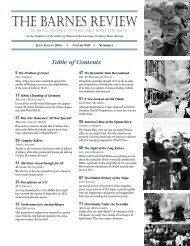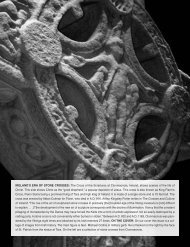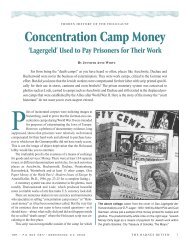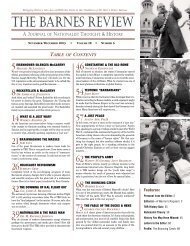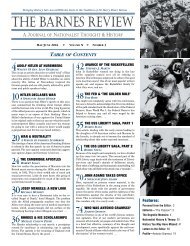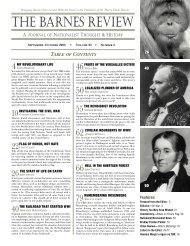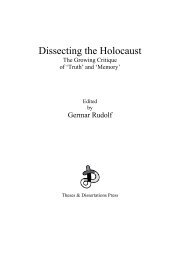Create successful ePaper yourself
Turn your PDF publications into a flip-book with our unique Google optimized e-Paper software.
WHO WAS ST. JOHN CHRYSOSTOM?<br />
Originally from Antioch in Syria, John Chrysostom<br />
was deeply im mersed in Greek scholarship and rhetoric.<br />
After meeting the saintly bishop Meletius<br />
around 367, he decided to become an ascetic and to<br />
enter the Orthodox Church (his father was a pagan). He was<br />
ordained a priest in 386, and began to write and preach at a<br />
level practically unheard of in the Near East at the time. His<br />
reputation for brilliance spread throughout both the eastern<br />
and western realms. He was consecrated as patriarch of<br />
Constantinople in 397, a See that he quickly reformed. His acid<br />
personality did not make him popular, but few doubted that his<br />
reforms were necessary. He ordered a drastic reduction in the<br />
expenses of the patriarchal household.<br />
He confined the “wandering<br />
monks” to their monasteries and<br />
in creased monastic discipline. His<br />
harsh language was generally di -<br />
rected against the wealthy members<br />
of the court circle in Byzantium<br />
who were not exactly used to being<br />
regularly condemned. It was not<br />
long before he was considered a<br />
great populist in economics.<br />
Chrysostom’s popularity always<br />
remained high with the middle and<br />
lower classes, but continually<br />
waned among the wealthy. Unfor -<br />
tunately, this contempt also spread<br />
to the arrogant and unintelligent<br />
em press, Eudoxia, who never<br />
ceased to cause the saint much difficulty. In so doing, the<br />
empress, always self-indulgent and pompous, made common<br />
cause with the Jews and polytheists against Chrysostom. In<br />
403, Chrysostom delivered a sermon condemning the extravagant<br />
tastes of Byzantine upper-class women, and the empress<br />
thought herself personally alluded to (which she probably was;<br />
St. John cared little whom he offended). After much in trigue,<br />
Chrysostom was uncanonically deposed. Again reinstated (af -<br />
ter Eudoxia thought a recent earthquake was a sign of divine<br />
disfavor for her actions), this fearless saint simply continued<br />
his speaking and writing against the luxury of the ruling class-<br />
es, speculative and pastoral theology,<br />
and scripture commentary (the latter<br />
for which he is right fully the most fa -<br />
mous).<br />
AN INTRODUCTION BY M. RAPHAEL JOHNSON, PH.D.<br />
St. John Chrysostom (from Chrysostomos, meaning “golden mouthed” or,<br />
as we would say, “golden tongued”), who lived within the confines of the<br />
Byzantine empire from c. A.D. 347 to 407, was the patriarch of Constantinople<br />
and one of the greatest theologians of the eastern church. He is a major saint<br />
in both the Roman Catholic and Orthodox churches, and the eastern church<br />
has given him the title of “ecumenical doctor” (along with Saints Gregory the<br />
<strong>The</strong>ologian and Basil the Great), meaning a teacher of the universal church.<br />
Dr. M. Raphael Johnson is the associate<br />
editor of THE BARNES REVIEW.<br />
After a gaudy silver statue of the empress was erected suspiciously<br />
near the Hagia Sophia (the Cathedral of the Divine<br />
Wisdom, the seat of the patriarchate), the saint railed against<br />
the pagan and Jewish Dionysian revelry that went on around<br />
it during its unveiling, timed purposely to coincide with church<br />
services. At this time, the desperate polytheists who remained<br />
within the Christian empire had formed an alliance of convenience<br />
with the Jews, whose contempt for Christian ways was<br />
well known.<br />
This homily is an edited version of one of Chrysostom’s<br />
speeches against the behavior of the Jews. It is often removed<br />
from compilations of Chrysostom’s work and is a source for<br />
continued Jew ish invective against the<br />
ancient church. It is primarily an at -<br />
tack on Jewish contempt for even their<br />
own (or allegedly their own) Torah (Old<br />
Tes tament) traditions, soon to be overthrown<br />
by the developing Talmudic law.<br />
This sermon’s heavy theological na ture<br />
was primarily meant to show that the<br />
Torah’s prophetic condemnations and<br />
criticisms of ancient Israel were still<br />
applicable in his day. In other words,<br />
Chrysostom approached the mat ter as<br />
a theologian. St. John sometimes uses<br />
flowery, theological—and oftentimes<br />
extremely harsh—language that might<br />
be unfamiliar or upsetting to some of<br />
our readers.<br />
It is republished here for several<br />
rea sons. First, it is published to show the mind of the ancient<br />
church (of which Chrysostom was one of the primary representatives)<br />
concerning the Jews. Second, it is a historical document<br />
that clearly shows, from a prescient and perceptive eyewitness,<br />
the behavior of the Jews in a Christian society that<br />
they despised. It is published, third, to show that the criticisms<br />
of Jewish behavior in recent decades are not different in any<br />
major respect than that of Chrysostom’s day. <strong>The</strong> saint’s popularity<br />
was such as to strongly suggest that the masses of<br />
Byzantium supported John’s position. St. John Chrysostom’s<br />
work is an example of a day when Christianity was truly<br />
orthodox, not tainted and watered down<br />
with liberal ideology, Jewish complaints<br />
and the burning desire to be accepted by<br />
the powerful classes. ❖



